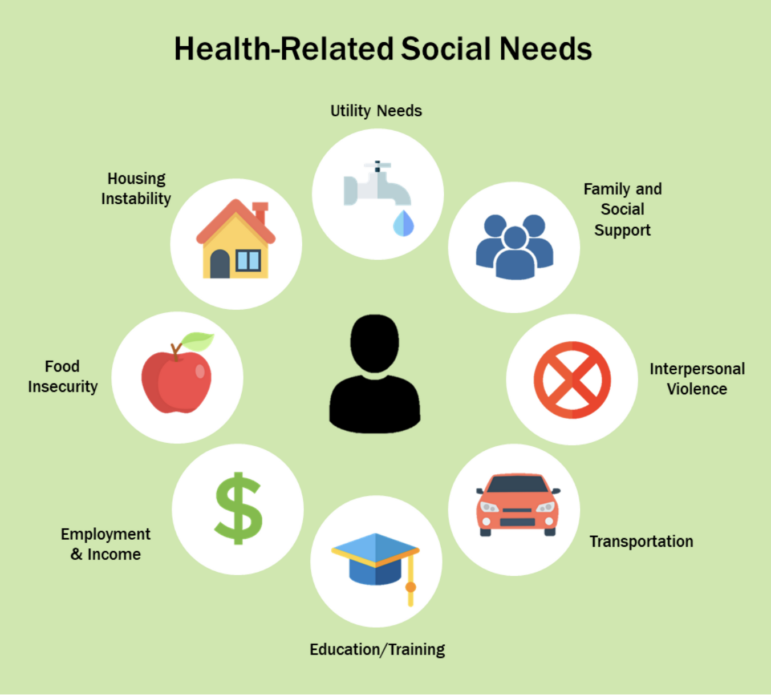How to improve health-related social needs screening
The clear connection between social factors and health has led to the adoption of health-related social needs screening in an attempt to address health concerns outside of clinic walls. How can we make sure these screeners and resulting referral services are effective?
An overview of Health-Related Social Needs
A large body of research shows that social factors like income, education, and neighborhood safety have a significant impact on our health, before we even step foot in a doctors’ office. Over the past two decades, clinicians and public health practitioners have increased their focus on upstream, preventative measures to address these social determinants of health.

Health-related social needs (HRSN) can result from adverse social determinants. For example, having a low income may hinder someone from being able to delead the paint in their house, despite it causing them immediate health issues. Targeting this specific HRSN would be an effective way to improve the patient’s health and prevent further health concerns down the road. In a situation like this, deleading the patient’s home is health care.
CMS supports HRSN screening
Many healthcare centers are already screening patients for HRSN, and the Centers for Medicare & Medicaid Services (CMS) will include HRSN screening as one of its key quality measures. In January, CMS outlined how states can be creative in using Medicaid-managed care plans to offer services targeting HRSN. Four states (Arizona, Arkansas, Massachusetts, and Oregon) have arranged for Medicaid coverage of rent/temporary housing for high-need individuals, and a recently approved California proposal allows for medically tailored meals, asthma remediation, and sobering centers as well. Creativity is encouraged if it means providing high-need individuals with the support that will keep them healthy.
On its face, this is beneficial. If clinicians can screen and identify HRSN, and if they can connect their patients with easy, effective assistance, the overall health of our population is likely to improve. However, HRSN screening can be detrimental if not approached with care.
HRSN screening: Proceed, but approach with caution
Healthcare guidance and support can only be effective if the patient trusts their care team. Unfortunately, American medicine has a spotty record of being trustworthy in certain communities. From the Tuskegee experiment to mistakenly reporting parents to social services to reporting abortion patients to the police, there are many reasons patients may trust their healthcare teams and may not want to self-report their HRSN.
Take pediatric HRSN screening, for example. A recent JAMA Viewpoint by Arvin Garg, MD, MPH; Alison LeBlanc, MS, PMP; and Jean L. Raphael, MD, MPH lays out why this screening isn’t necessarily welcomed by all parents.
Despite parental support for HRSN screening and an opportunity for parents to connect and receive support from their pediatrician, there is also great concern particularly from low-income minoritized parents. Their concerns include feelings of shame, being judged and discriminated against by the health care team, fear that disclosing needs will lead to filings with child protective services and removal of their children, and frustration with disclosing sensitive needs without getting acknowledgment and help.
Arvin Garg, MD, MPH; Alison LeBlanc, MS, PMP; and Jean L. Raphael, MD, MPH in JAMA Viewpoint
This doesn’t mean that HRSN screening should be completely scrapped, but it should be developed and implemented with care and caution.
The authors of the JAMA Viewpoint identify a few ways to ensure equitable and empathetic HRSN screening. Their recommendations include:
- Let the patient lead. If the patient chooses not to seek assistance for social needs, that decision must be respected.
- Incentivizing health systems to partner with patients in addressing their HRSN
- Shifting from screening for social risk (identifying adverse social factors in patients’ lives) towards social needs (asking about an individual’s priorities and perceptions of what they need)
- Training hospital staff on unconscious bias and cultural humility so as to not cause further harm
- Collaborating with patients, staff, and community members to design social care support programs
- Advocating for a stronger social safety net. Ultimately, social policies will be needed to address HRSN. Health systems, staff, and patients alike should not hesitate to advocate voraciously for those policies.
Patience and persistence are also needed to overcome challenges in the long term. For example, the CMS evaluation report of their Accountable Health Communities Model found that while food insecurity was the most prevalent and persistent HRSN and beneficiaries with food needs were the most likely to use community services, this HRSN was unlikely to be fully resolved during the three year time period. This is indicative of the challenge of addressing unmet social needs in the long term; these problems did not appear overnight, nor will they be fixed overnight.
For HRSN screening to be effective, it requires trust between patient and provider. Kaiser Permanente found that something as simple as explaining why screening questions are being asked and how that information may be used has an impact on a patient’s willingness to divulge. Referral services should also be evaluated to ensure patients are provided with effective services in a timely manner; after all, screening is not particularly useful if nothing is done with the results.
Regulatory bodies that set the standards for healthcare facilities can help by incentivizing health systems to adopt HRSN screening and solutions. The January 2023 guidance from CMS is a great starting point as it allows states to customize their services based on specific needs.
When we approach it with humility and empathy, HRSN screening can be impactful. Addressing health-related social needs can be an effective way to quickly improve the health and life conditions of patients, and we should continue to push for progress in this area.
